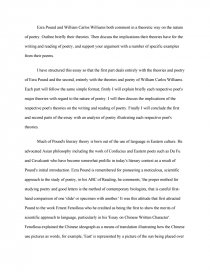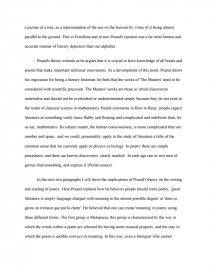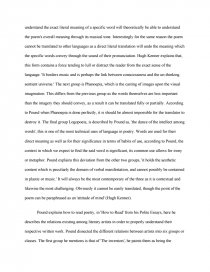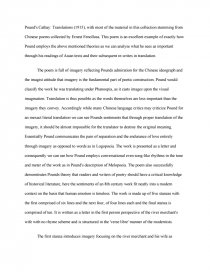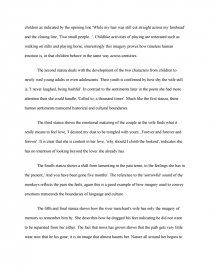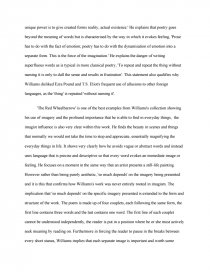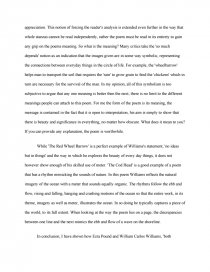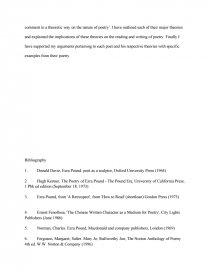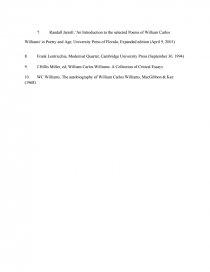Ezra Pound & William Carlos Williams: Theories on the Nature of Poetry
Essay by review • March 14, 2011 • Research Paper • 3,639 Words (15 Pages) • 3,531 Views
Essay Preview: Ezra Pound & William Carlos Williams: Theories on the Nature of Poetry
Ezra Pound and William Carlos Williams both comment in a theoretic way on the nature of poetry. Outline briefly their theories. Then discuss the implications their theories have for the writing and reading of poetry, and support your argument with a number of specific examples from their poems.
I have structured this essay so that the first part deals entirely with the theories and poetry of Ezra Pound and the second, entirely with the theories and poetry of William Carlos Williams. Each part will follow the same simple format; firstly I will explain briefly each respective poet's major theories with regard to the nature of poetry. I will then discuss the implications of the respective poet's theories on the writing and reading of poetry. Finally I will conclude the first and second parts of the essay with an analysis of poetry illustrating each respective poet's theories.
Much of Pound's literary theory is born out of the use of language in Eastern culture. He advocated Asian philosophy including the work of Confucius and Eastern poets such as Du Fu and Cavalcanti who have become somewhat prolific in today's literary context as a result of Pound's initial introduction. Ezra Pound is remembered for pioneering a meticulous, scientific approach to the study of poetry, in his ABC of Reading, he comments, 'the proper method for studying poetry and good letters is the method of contemporary biologists, that is careful first-hand comparison of one 'slide' or specimen with another.' It was this attitude that first attracted Pound to the work Ernest Fenollosa who he credited as being the first to show the merits of scientific approach to language, particularly in his 'Essay on Chinese Written Character'. Fenollosa explained the Chinese ideograph as a means of translation illustrating how the Chinese use pictures as words, for example, 'East' is represented by a picture of the sun being placed over a picture of a tree, as a representation of the sun on the horizon by virtue of it being almost parallel to the ground. This in Fenollosa and in turn Pound's opinion was a far more honest and accurate manner of literary depiction than our alphabet.
Pound's theory extends as he argues that it is crucial to have knowledge of all books and poems that make important technical innovations. As a development of this point, Pound shows his inspiration for being a literary historian, he feels that the works of 'The Masters' need to be considered with scientific precision. The Masters' works are those in which discoveries materialise and should not be overlooked or underestimated simply because they do not exist in the realm of classical science or mathematics. Pound comments in How to Read, 'people regard literature as something vastly more flabby and floating and complicated and indefinite than, let us say, mathematics. Its subject matter, the human consciousness, is more complicated than are number and space...and we could, presumably, apply to the study of literature a little of the common sense that we currently apply to physics or biology. In poetry there are simple procedures, and there are known discoveries, clearly marked...In each age one or two men of genius find something, and express it' (Polite essays).
In the next two paragraphs I will show the implications of Pound's theory on the writing and reading of poetry. Here Pound explains how he believes people should write poetry, 'great literature is simply language charged with meaning to the utmost possible degree' or 'dans ce genre on n'emeut que par la clarte'. He believed that one can create 'meaning' in poetry using three different forms. The first group is Melopoeia, this group is characterised by the way in which the words within a poem are selected for having some musical property, and the way in which the poem is audible conveys its meaning. In this way, even a foreigner who cannot understand the exact literal meaning of a specific word will theoretically be able to understand the poem's overall meaning through its musical tone. Interestingly for the same reason the poem cannot be translated to other languages as a direct literal translation will undo the meaning which the specific words convey through the sound of their pronunciation. Hugh Kenner explains that, this form contains a force tending to lull or distract the reader from the exact sense of the language. 'It borders music and is perhaps the link between consciousness and the un-thinking sentient universe.' The next group is Phanoepia, which is the casting of images upon the visual imagination. This differs from the previous group as the words themselves are less important than the imagery they should convey, as a result it can be translated fully or partially. According to Pound when Phanoepia is done perfectly, it is should be almost impossible for the translator to destroy it. The final group Logopoeia, is described by Pound as, 'the dance of the intellect among words', this is one of the most technical uses of language in poetry. Words are used for their direct meaning as well as for their significance in terms of habits of use, according to Pound, the context in which we expect to find the said word is significant, its common use allows for irony or metaphor. Pound explains this deviation from the other two groups, 'it holds the aesthetic content which is peculiarly the domain of verbal manifestation, and cannot possibly be contained in plastic or music.' It will always be the most contemporary of the three as it is contextual and likewise the most challenging. Obviously it cannot be easily translated, though the point of the poem can be paraphrased as an 'attitude of mind' (Hugh Kenner).
Pound explains how to read poetry, in 'How to Read' from his Polite Essays, here he describes the relations existing among literary artists in order to properly understand their respective written work. Pound dissected the different relations between artists into six groups or classes. The first group he mentions is that of 'The inventors', he paints them as being the 'discoverers of a particular process or of more than one mode and process'. He goes on to say that these people can be 'known or discoverable', providing the example of Arnaut Daniel who introduced certain methods of rhyming. The Second group is that of the 'The Masters'. This is the smallest of the classes as there are few real ones. He applies the term to inventors who apart from their own inventions, are able to incorporate and develop a 'large number of preceding inventions'. The third group is, 'The diluters', he describes this group as being those who follow
...
...
